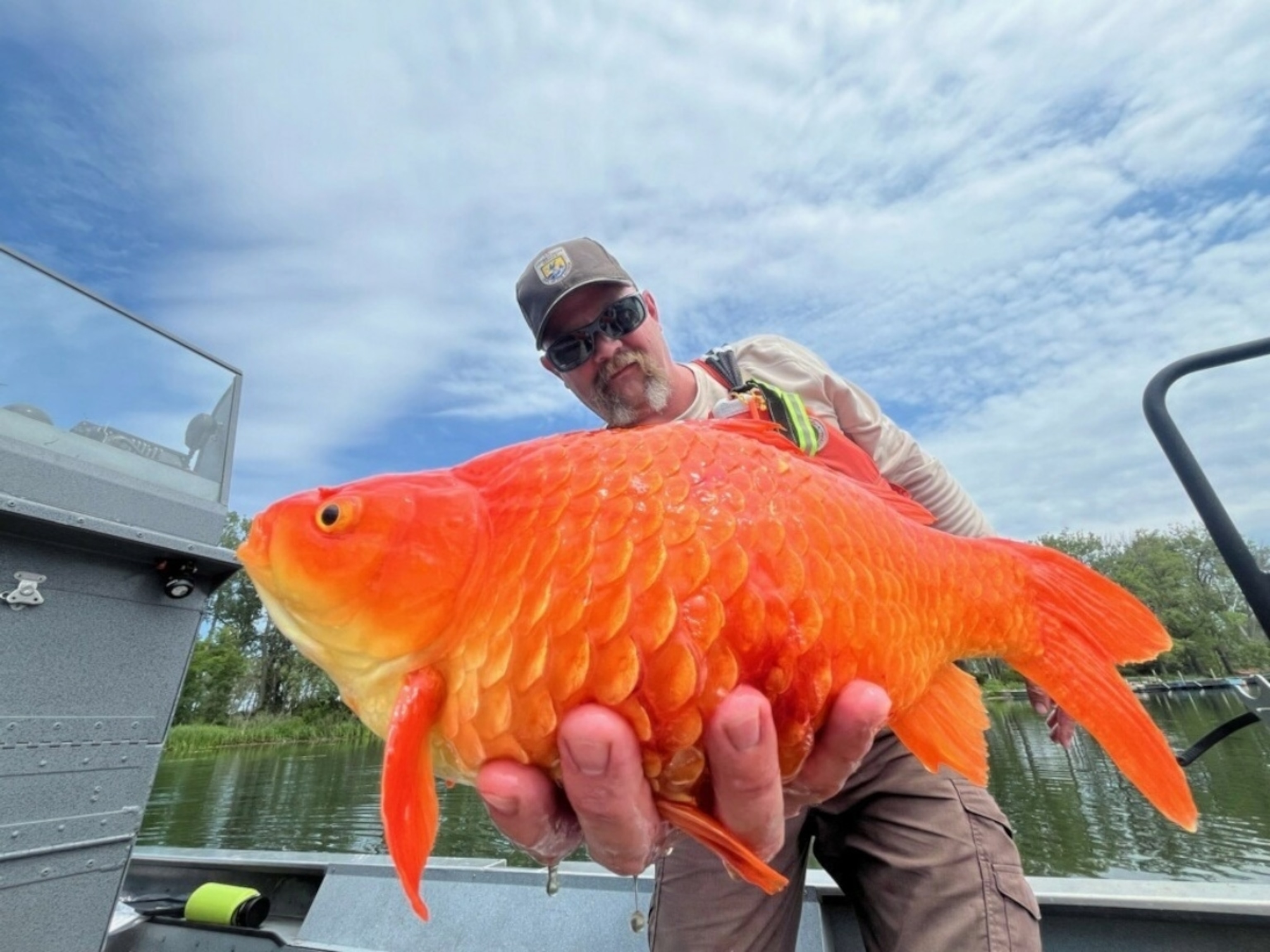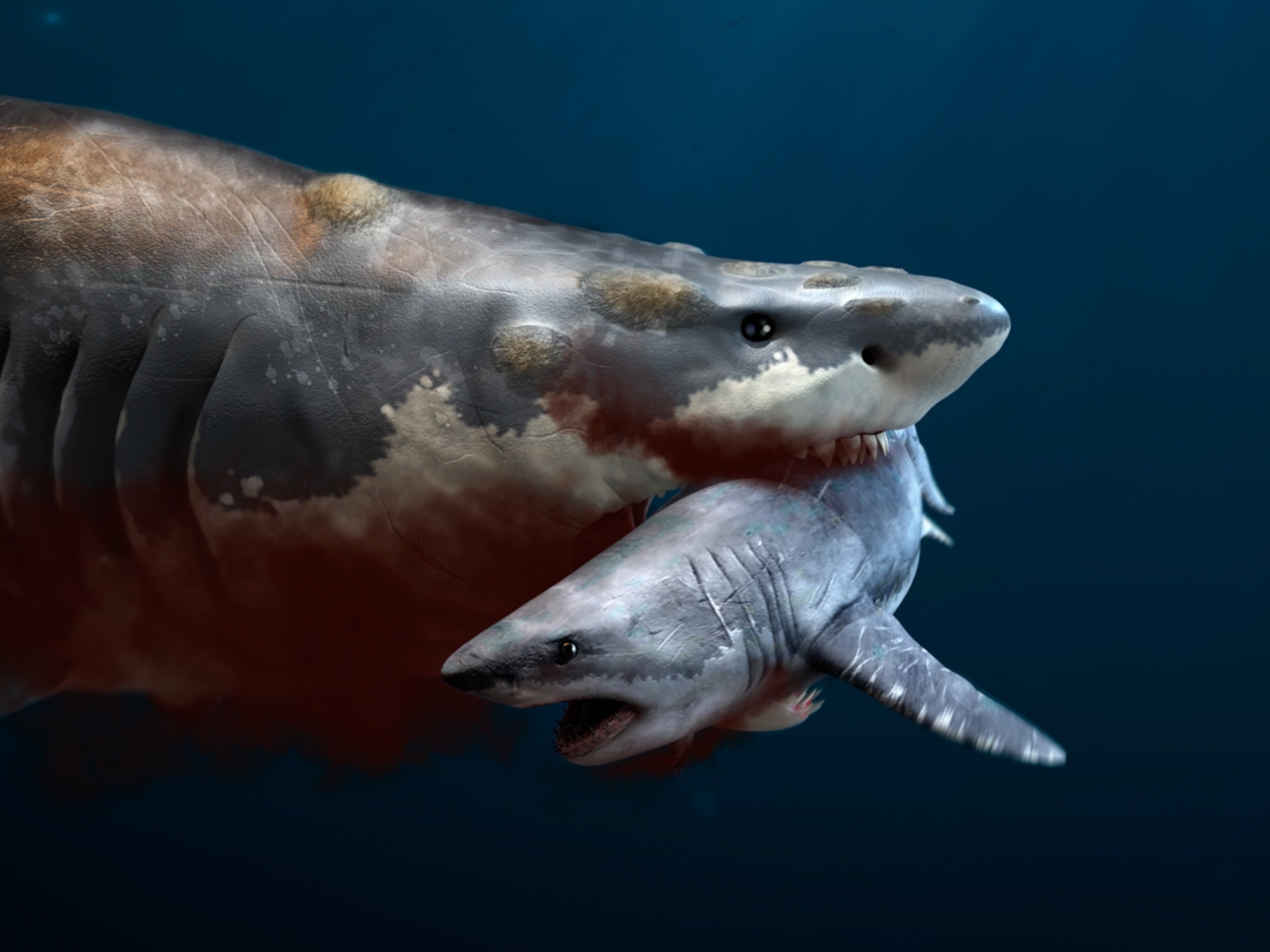How this ‘Megalodon’ goldfish got so huge
Goldfish possess genetic traits that allow them to swell up to four pounds—the size of a Chihuahua. Experts say that's why you shouldn't release them into the wild.

Thinking about freeing your pet goldfish from their tank and letting them loose in a local pond or lake?
Please don’t, begs the U.S. Fish and Wildlife Service in a recent social media post. In just two years, that harmless fish you know as “Mr. Bubble Guppy” can turn into an ecosystem-wrecking leviathan.
And while most pet goldfish would fit comfortably in your palm, some giant ones that officials have caught in the wild weigh as much as 4 pounds. That’s about the size of a Chihuahua.
Goldfish, also known as Carassius auratus, were domesticated in China about 1,000 years ago and became popular in the U.S. as pets during the late 1800s. But these freshwater fish from the carp family have increasingly been set loose in the wild, either by pet owners who don’t want to keep them or who believe they’re doing a good deed by setting them free.
(Maybe megalodon wasn’t so chonky after all.)
The giant goldfish in the U.S. Fish and Wildlife Service post, jokingly nicknamed “megalodon” after an ancient shark, was found in Lake Erie, but goldfish have been reported in all the Great Lakes, with higher concentrations near harbors and bays—likely the result of pet goldfish releases, coupled with natural reproduction, says Christina Meister of the USFWS’s Office of Public Affairs.
In fact, the goldfish—a staple of many childhoods—has now established wild populations in every U.S. state except Alaska.
And while you might expect a shiny, tangerine-colored fish to be a tasty snack for native walleye or bass, many predators aren’t large enough to gulp one down.
“With enough resources, goldfish can grow very quickly, especially in the absence of top predators,” says Christine Boston, an aquatic and research biologist with Fisheries and Oceans Canada. Essentially, they can become too big for Great Lakes fish and top predators to consume.
“Try eating a football,” Boston jokes.
How do goldfish grow so big?
More food equals bigger fish, but goldfish also possess genetic traits that allow them to swell in size, says Kinya Ota, a zoologist at Academia Sinica in Taiwan, who is also the author of Goldfish Development and Evolution.
While the genetic underpinnings for this phenomenon have not been studied, one experiment showed that when goldfish were given feed with varying amounts of protein and fat, those that received the most nutrient-rich food grew fastest.
This could mean that when wild goldfish have access to higher-quality food in greater quantities, it allows them to attain epic proportions.
This is something pet owners sometimes see at home too.
“Occasionally, in a fish tank, goldfish engage in cannibalism, and sometimes an exceptionally large individual emerges,” says Ota.
The threat posed by goldfish
Believe it or not, goldfish can have an impact on the ecosystems they invade.
For starters, freed goldfish vacuum up native fish eggs, larvae, and even other adult fish, potentially contributing to the decline of various species, and they’ve also been linked to the loss of native invertebrates. What’s more, they can reproduce multiple times each season, allowing their numbers to balloon if unchecked.
Some research has also suggested that goldfish suck up mouthfuls of sediment and then spit them back out. This not only muddies water quality, but can ultimately trigger algal blooms, which can rapidly reduce the amount of oxygen in the water, killing fish in the process. Another study found that passing through a goldfish’s intestines can actually give blue-green, toxin-creating cyanobacteria a boost, helping harmful bacteria to grow.
What’s more, goldfish may be getting a helping hand from climate change.
“They can thrive in areas where other fish can’t because of their tolerance to a wide range of oxygen and temperature scenarios,” says Boston, who has tracked goldfish in the western tip of Lake Ontario. “Warmer water has less oxygen, so if waters are warming [because of] climate change, they could have an advantage over native species that prefer cooler water and need more oxygen.”
One thing seems clear, though. While sightings of “megalodon” goldfish invoke strong reactions on social media when they bubble up, seeing goldfish in the wild is no longer a rare occurrence.
In one pond, Boston and her team removed 20,000 goldfish in 2021 before the water body was dredged for maintenance. When they returned a year later, the number of goldfish had already repopulated to about 10,000 fish. So, reconsider before releasing that pet goldfish, and find a way to rehome it instead.
“They have been detected more and more frequently in the wild over the last decade,” Boston says. “They are not out of the ordinary anymore.”





